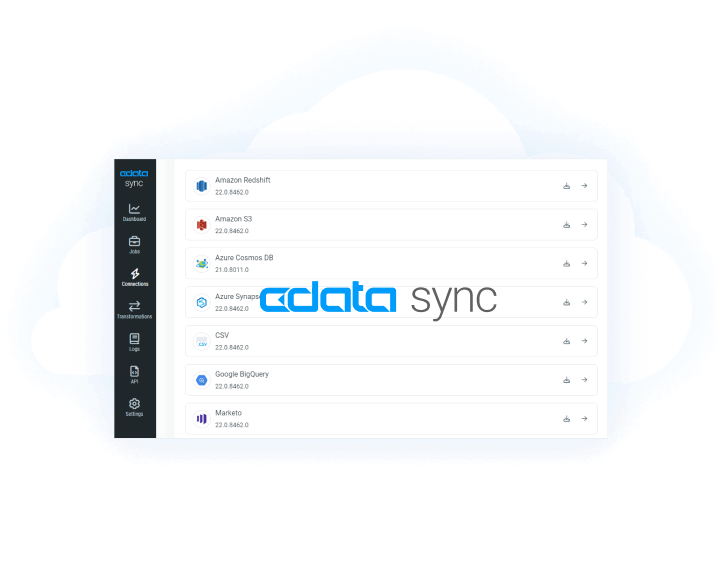Discover how a bimodal integration strategy can address the major data management challenges facing your organization today.
Get the Report →Extend Google Sheets with Authorize.Net Data
Make calls to the API Server from Google Apps Script.
Interact with Authorize.Net data from Google Sheets through macros, custom functions, and add-ons. The CData API Server, when paired with the ADO.NET Provider for Authorize.Net (or any of 200+ other ADO.NET Providers), enables connectivity to Authorize.Net data from cloud-based and mobile applications like Google Sheets. The API Server is a lightweight Web application that produces OData services for Authorize.Net and any source supported by the CData ADO.NET Providers.
Google Apps Script can consume these OData services in the JSON format. This article shows how to create a simple add-on that populates a Google Spreadsheet with SettledBatchList data.
Set Up the API Server
Follow the steps below to begin producing secure Authorize.Net OData services:
Deploy
The API Server runs on your own server. On Windows, you can deploy using the stand-alone server or IIS. On a Java servlet container, drop in the API Server WAR file. See the help documentation for more information and how-tos.
The API Server is also easy to deploy on Microsoft Azure, Amazon EC2, and Heroku.
Connect to Authorize.Net
After you deploy the API Server and the ADO.NET Provider for Authorize.Net, provide authentication values and other connection properties needed to connect to Authorize.Net by clicking Settings -> Connections and adding a new connection in the API Server administration console.
You can obtain the necessary connection properties on the Security Settings -> General Settings page after logging into your Merchant Account.
- UseSandbox: The Authorize.Net API to be used to process transactions. If you are using a production account, this property can be left blank. If you are using a developer test account, set this to 'TRUE'.
- LoginID: The API login Id associated with your payment gateway account. This property is used to authenticate that you are authorized to submit website transactions. Note that this value is not the same as the login Id that you use to log in to the Merchant Interface.
- TransactionKey: The transaction key associated with your payment gateway account. This property is used to authenticate that you are authorized to submit website transactions.
You can then choose the Authorize.Net entities you want to allow the API Server to access by clicking Settings -> Resources.
Authorize API Server Users
After determining the OData services you want to produce, authorize users by clicking Settings -> Users. The API Server uses authtoken-based authentication and supports the major authentication schemes. Access can also be restricted based on IP address: Connections from all addresses except localhost are blocked by default, so you will need to allow connections from Google's servers for this article. You can authenticate as well as encrypt connections with SSL.
Retrieve Authorize.Net Data
Open the Script Editor from your spreadsheet by clicking Tools -> Script Editor. In the Script Editor, add the following function to populate a spreadsheet with the results of an OData query:
function retrieve(){
var url = "https://MyUrl/api.rsc/SettledBatchList?select=Id,MarketType,TotalCharge,IncludeStatistics";
var response = UrlFetchApp.fetch(url,{
headers: {"Authorization": "Basic " + Utilities.base64Encode("MyUser:MyAuthtoken")}
});
var json = response.getContentText();
var sheet = SpreadsheetApp.getActiveSheet();
var a1 = sheet.getRange('a1');
var index=1;
var settledbatchlist = JSON.parse(json).value;
var cols = [["Id","MarketType","TotalCharge","IncludeStatistics"]];
sheet.getRange(1,1,1,4).setValues(cols);
row=2;
for(var i in settledbatchlist){
for (var j in settledbatchlist[i]) {
switch (j) {
case "Id":
a1.offset(row,0).setValue(account[i][j]);
break;
case "MarketType":
a1.offset(row,1).setValue(account[i][j]);
break;
case "TotalCharge":
a1.offset(row,2).setValue(account[i][j]);
break;
case "IncludeStatistics":
a1.offset(row,3).setValue(account[i][j]);
break;
}
}
row++;
}
}
Follow the steps below to add an installable trigger to populate the spreadsheet when opened:
- Click Resources -> Current Project's Triggers -> Add a New Trigger.
- Select retrieve in the Run menu.
- Select From Spreadsheet.
- Select On open.
After closing the dialog, you are prompted to allow access to the application.
You can test the script by clicking Publish -> Test as Add-On. Select the version, installation type, and spreadsheet to create a test configuration. You can then select and run the test configuration.






